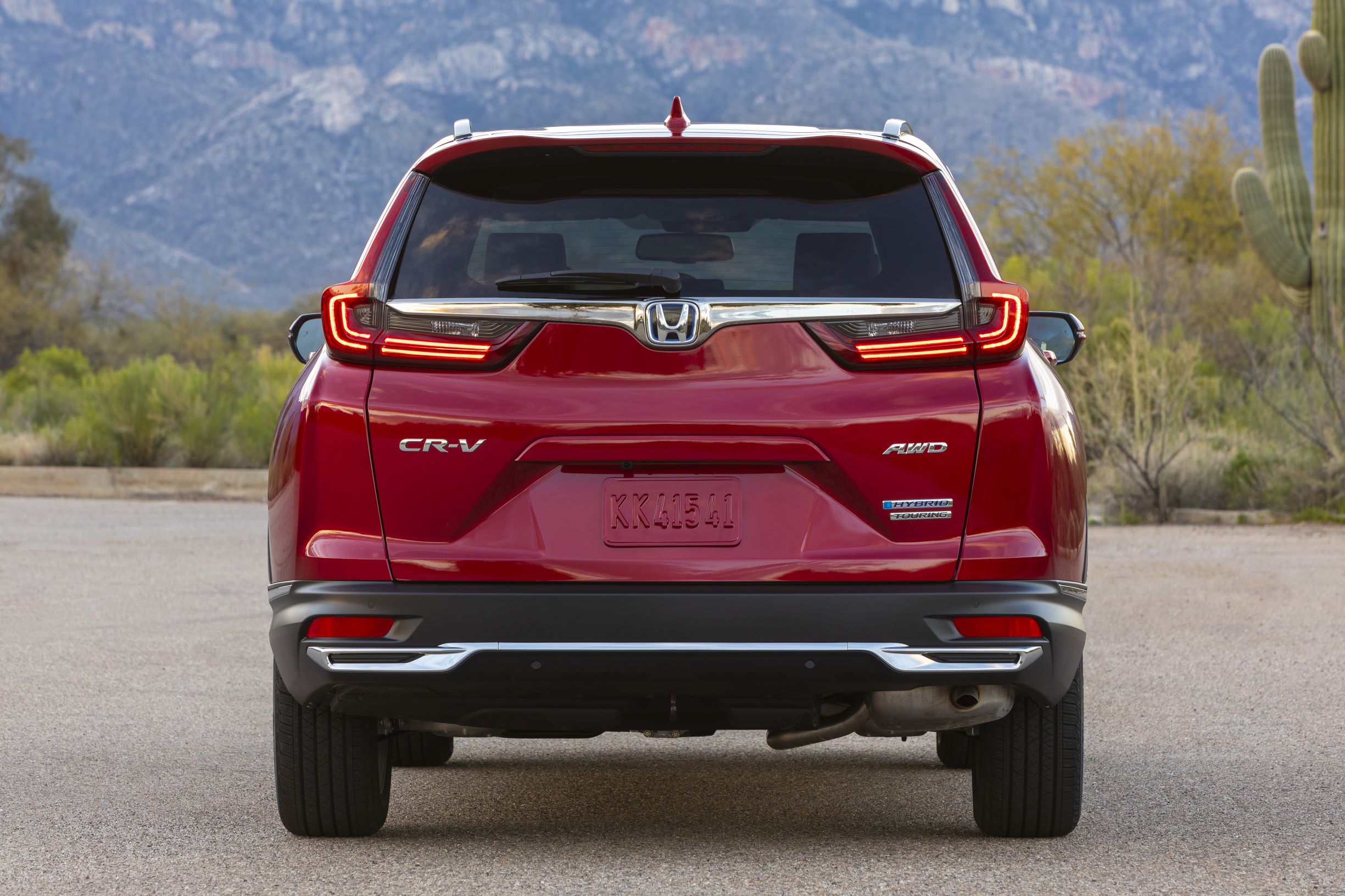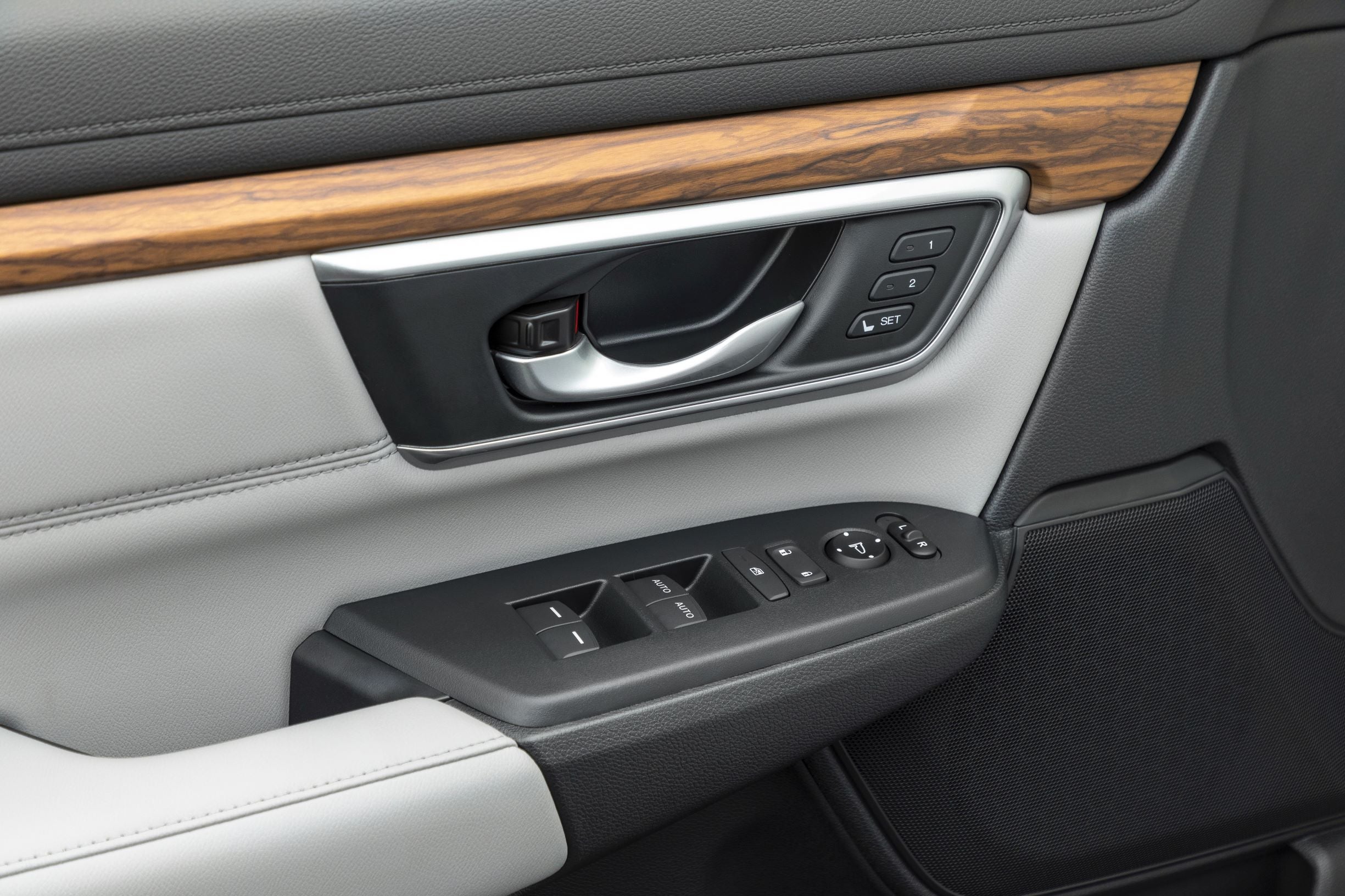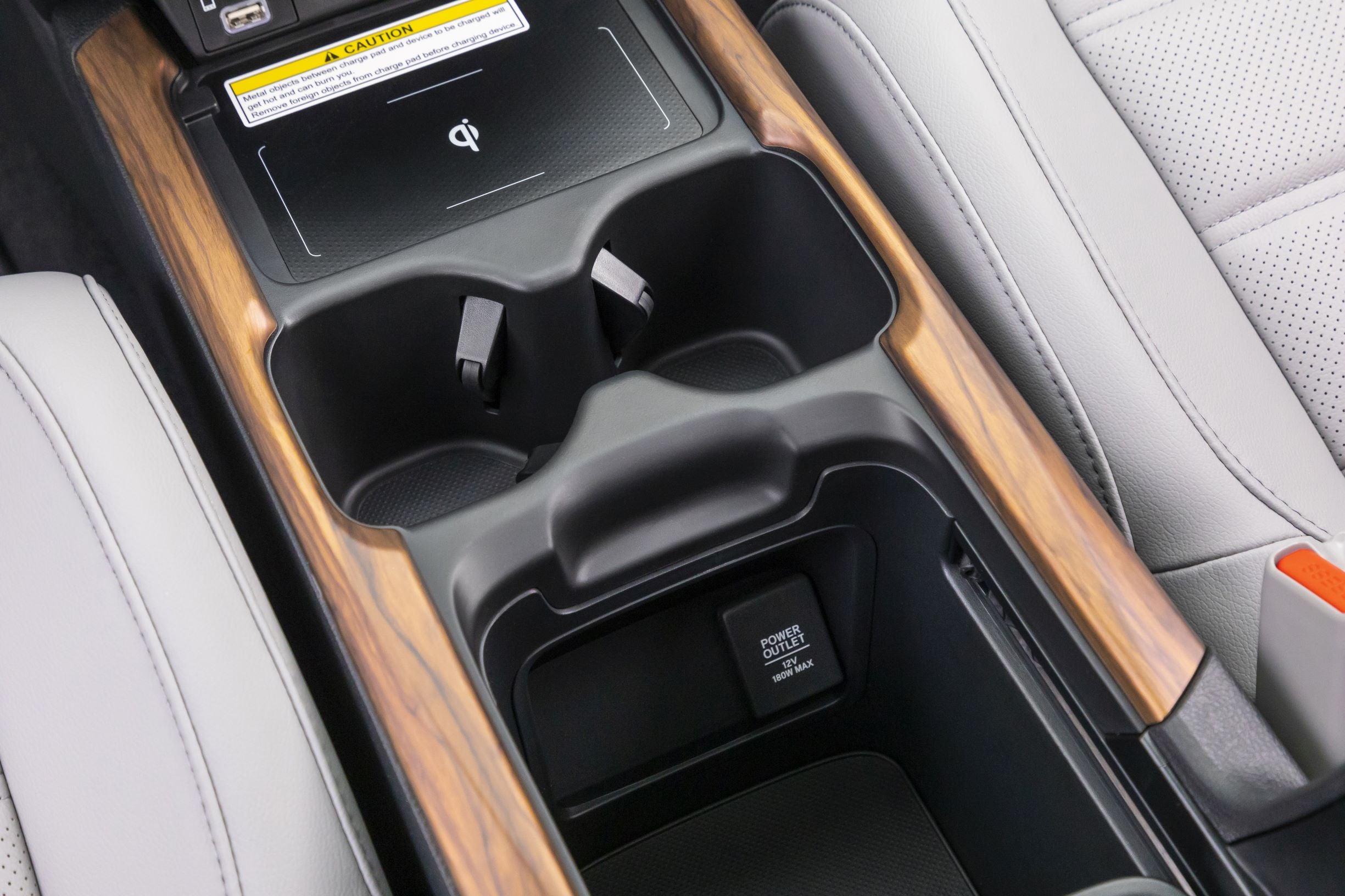Fun fact: Despite recently being crowned America's most fuel-efficient full-line automaker, the Honda brand has never offered an electrified SUV here in America. No hybrids, no plug-ins, no nuthin'. Toyota's been electrifying the RAV4 and Highlander for years now, while Honda has shied away from an eco-conscious SUV. Seven years after the RAV4 Hybrid's birth and a whole 23 years since the CR-V was first introduced, the drought comes to an end with the 2020 Honda CR-V Hybrid.
Don’t think the CR-V has traded in the sporty-for-its-class rep for a better EPA rating, though, because the days of hybrid variants being the underpowered, dowdy option are long over. Honda is touting its latest Hybrid as not just the most fuel-efficient CR-V ever but also the most powerful and refined one to date. The one you want, as it were.
It's taken forever and a day to get to an electrified CR-V, and at a time where automakers are pledging a complete lineup transformation and 836 new electric cars on the market by 2024, Honda's grand plans for the future look comparatively conservative. It aims to have 50 percent of all the cars it sells be hybrid and 15 percent be full EVs by 2030.
But that makes sense: Last year, hybrids accounted for just 7 percent of Honda's pie while, in the U.S. at least, the company has yet to introduce a production-ready electric car. The company has a lot of ground to cover and considering how much America loves its crossovers, there's quite a bit riding on the CR-V Hybrid's shoulders.
The 2020 Honda CR-V Hybrid, By the Numbers
- Base Price (Price as Tested): $28,870 ($37,070)
- Powertrain: 2.0-liter Atkinson-cycle inline-four with two electric motors (one propulsion motor and one generator/starter motor) and a 1.4 kWh lithium-ion battery | drive force transfer "eCVT" | all-wheel drive
- EPA Fuel Economy: 40 mpg city | 35 mpg highway | 38 mpg combined
- Horsepower: 212 horsepower @ 6,200 rpm
- Torque: 232 pound-feet @ 0—2,000 rpm (electric propulsion motor) | 129 pound-feet of torque @ 3,500 rpm (gas engine)
- Seating Capacity: 5
- Cargo Volume: 33.2 cubic feet (rear seats up) | 68.7 cubic feet (rear seats down)
- Curb Weight: 3,649 (LX) — 3,763 pounds (Touring)
- The Promise: The best, most efficient version of one of the most practical cars on sale today.
- The Delivery: A very good runabout vehicle that ultimately falls short of its main competition.
The current-generation Honda CR-V has been around since 2017 and to keep things fresh, Honda has given its compact crossover lightly reworked front and rear fascias as well as smokier taillights for its 2020 mid-cycle refresh. New 19-inch wheels exclusive to the Touring trim are, in my eyes, markedly more attractive than the old rims. Visually differentiating the Hybrid version from the solely gas-powered CR-V are five-LED fog lights for trims EX and up, a slightly different chrome rear bumper trim, hidden exhaust tips, and, of course, blue Honda and Hybrid badging.
There's nothing outwardly offensive about its design but there's also little beauty to write home about here. While Honda's sedan lineup is mostly made of sculpted edges and stately stances, the CR-V looks portly. Like a lifted Civic that had a few too many donuts.
Not much has changed on the inside either. Honda has revised the center cubby storage area to fit more stuff, lit up the two USB ports up front, and now includes wireless charging on the Touring; the Hybrid, in particular, gets hybrid-related displays in the digital gauge cluster, a push-button gear selector inherited from Acura in lieu of the gas-only CR-V's traditional lever, and buttons to choose between Sport, Econ, and EV driving modes.
Like its exterior, the CR-V's cabin was likely designed with function in mind rather than form. It's comfortable, reasonably spacious, and intuitively laid out but not especially life-changing to behold. The fake stamped "stitching" and wood-pattern trim aren't fooling anybody and harder-than-expected plastics are disappointing mostly because we know Honda can do so much better (see: the Accord's magnificent cabin). However, I'm a fan of how the CR-V's seven-inch infotainment touchscreen has been integrated. Yes, it's another example of the "tacked-on iPad" look but it's well-thought-out and fits with the rest of the space.
Less impressive is the infotainment system itself which has been around since the middle of the previous decade, uses an industrial-looking UI, and is somewhat cumbersome to navigate. (Again, one only needs to take a look at the Accord to find a Honda infotainment system that doesn't suck.) Thankfully, it's equipped with Apple CarPlay and Android Auto on all trims bar the base LX so provided you get a non-base CR-V and own a reasonably modern smartphone, the dated infotainment may not be an issue.
While we're on the subject of tech, all versions of the 2020 Honda CR-V now come with the company's full suite of Honda Sensing active safety and assisted driving systems. This includes:
- Collision Mitigation Braking System with Forward Collision Warning and pedestrian sensing capability
- Road Departure Mitigation with Lane Departure Warning
- Adaptive Cruise Control with low-speed follow
- Lane Keeping Assist
One Honda safety gizmo that's missing is the LaneWatch blindspot camera mounted in the right-side mirror, activated by the right turn signal. When we asked a Honda rep where it had gone, he explained that while LaneWatch was a nifty parlor trick and cheaper to produce than radar-based blindspot monitoring, the camera-based system is ultimately less safe since it takes more time for the average human to process whether or not a car is within the red-and-orange lines than it does to register whether an LED icon is lit or not on the actual mirror. Putting the safety of your customers ahead of potential cost-cutting and additional profits? Now, that's an idea.
In terms of outright space, the CR-V Hybrid's rear quarters are roomy—the Honda boasts rearseat legroom measuring 2.7 inches longer than the Toyota RAV4 Hybrid and 1.5 inches longer than Ford's new Escape Hybrid. So, if backseat square-footage is the only thing you care about (which, for certain demographics, isn't that preposterous of a premise), you can stop reading now because the CR-V is your winner.
Moving back into the cargo area, however, the Honda is less dominant. Thanks to the big battery that's located underneath the trunk, the CR-V Hybrid's 33.2 cubic feet of cargo volume is a whole six cubic feet less than what you get in the non-Hybrid CR-V and 4.3 cubic feet smaller than the RAV4 Hybrid, a car which carries its batteries underneath the second-row of seats. Because of where Honda has chosen to locate the CR-V Hybrid's lithium, it also does not come with a spare tire whereas both the regular CR-V and RAV4 Hybrid do. Not a dealbreaker for most but something to keep in mind.
Two Motors, One Clutch
Outwardly, the 2020 Honda CR-V Hybrid may be pretty straightforward but under the surface, things get a little complicated. While most hybrids are powered mainly by a gas engine with one, sometimes two, electric motors providing additional and alternative thrust, Honda's two-motor system reverses these roles, putting electricity front and center and relegating the internal combustion engine to a supporting part.
Like the Accord Hybrid, the CR-V Hybrid uses a 2.0-liter four-cylinder and two electric motors: one that propels the wheels and another that acts as a generator. Most of the time, the 181-hp propulsion electric motor is solely responsible for moving the car while the gas engine pumps electricity to the propulsion motor and charges the trunk-mounted, 1.4-kWh battery via the generator motor. Keeping speeds low, the gas engine can turn off completely, effectively turning the CR-V Hybrid into a full EV for up to around one mile. Above approximately 45 mph, a single lock-up clutch can connect the 143-hp gas engine directly to the wheels during "light-load cruising." One of the main benefits of this system is that the CR-V Hybrid eschews the need for any heavy, power-sapping automatic transmissions or even pulley-based CVTs.
[Note: Honda sometimes refers to this drive force transfer system as an "eCVT" in the CR-V Hybrid's marketing but that's largely a misnomer meant to keep things simple for the buying public.]
Innovation, it seems, doesn't always come out ahead because the EPA has rated the CR-V Hybrid at 40 mpg city/35 highway/38 combined which is predictably better than the non-Hybrid AWD CR-V's scores of 27/33/29 mpg but all around worse than either of its hybrid rivals from Toyota and Ford which get 41/38/40 and 43/37/40 mpg, respectively.
To be fair, the CR-V lays down the most torque out of the three hybrids (232 pound-feet versus the RAV4's 203 and the Escape's 155) and true green-heads will appreciate the absence of rare earth metals in both of the Honda's electric motors. And in the grand scheme of things, 38 combined mpg in a car of this size is hardly a crime against the environment. But if outright efficiency is ultimately what you want from your hybrid crossover, things aren't looking too good for the CR-V.
A Conventional Drive, For Better and Worse
While the theory behind Honda’s two-motor hybrid system and its relatively unimpressive efficiency numbers take a while to digest, things are way more straightforward when the rubber meets the road. As we discovered with the Insight and Clarity, Honda's hybrid strategy is to make the electrified motoring experience a familiar one and the CR-V Hybrid definitely falls in line with that ethos.
Most of the time, you'd barely be able to tell the CR-V Hybrid was even a hybrid let alone one with such an unconventional powertrain underneath it. By design, the gas engine's revs increase with speed linearly under normal driving and changes between electric drive, hybrid drive, and full-engine drive modes are seamless and almost imperceptible.
Okay, so there are some electric whirring sounds that creep into the cabin at low speeds and flooring it from a stop causes the gas engine to scream and awkwardly hold its revs but, all in all, there's less powertrain wonkiness here than some conventional gas cars with badly-calibrated CVTs.
The CR-V Hybrid also easily accomplishes its mission as being the CR-V to get over the regular gas model. Compared to that version's 1.5-liter turbo, the electrified hardware is stronger, more efficient, and more desirable. The CR-V Hybrid's 2.0-liter also sounds marginally nicer than the 1.5, if that sort of thing matters to you.
Other driving-related observations? Its steering is responsive enough and doesn't feel completely dead while its suspension soaks up bumps fuss-free. Granted, the roads of Tucson, Arizona Honda brought us out on weren't particularly terrible but at no point in the drive did I feel bothered by any potholes or expansion joints. Or perhaps the roads of the Old Pueblo are actually bad and I just hadn't noticed. Its brakes are more sensitive than average but remain easy to use smoothly. All of its inputs, in fact, feel easy to use smoothly. This is a drama-free commuter vehicle through-and-through.
What it isn't, however, is particularly fun.
Point the CR-V Hybrid at some curves and you'll find that it's an alright handler for what it is but there's nothing here that goads you on to misbehave or reward you for keeping your foot down and the G-forces high. It's a stoically competent driving experience which we'd be perfectly okay with for a car like this if it weren't for that other Japanese hybrid compact crossover.
Heavy Competition
In addition to the red CR-V Hybrid Touring we tested, Honda also brought along copies of Toyota's RAV4 Hybrid for us to sample. A bold move on Honda's part and one that ultimately won't prove rewarding because after driving them back-to-back, we preferred the RAV4.
On top of having a more chiseled, rugged, and cohesive design inside-and-out, the RAV is more entertaining to pilot thanks to its tighter, less-corrupted steering feel and stiffer, more compact-feeling modular platform. The Toyota somehow simultaneously feels like less of an appliance but also a better appliance.
Oh, and it also gets better fuel economy.
It's not quite a landslide win. The RAV4 Hybrid rides a little harsher and is noticeably more cramped inside. In kinder terms, we could say the CR-V adopts a more old-school definition of luxury with its more expansive real estate and softer suspension, which is perfectly fine. But the name of this internet website is The Drive, and behind the wheel, the Toyota has this Honda beat.
Verdict
By most measures, the 2020 Honda CR-V Hybrid is a good car—a very good car, even. It's comfortable, practical, and well-built. We admire the engineering, innovation, and care Honda's put into developing it and it definitely achieves its goal as being the best CR-V on sale today—and, in turn, the best CR-V Honda has ever made. But in the face of heavy competition, lagging efficiency stats, somewhat frumpy styling, relatively stoic driving manners, and a dated infotainment system keep it from greatness. If it was our money, we'd take a Toyota RAV4 Hybrid almost every day of the week. So maybe, like, five days a week.
That said, if you're in the market, this new Hybrid CR-V remains worthy of your attention because, given different priorities and preferences, it might just be a better fit than the competing Toyota. Realistically, very few owners of the 2020 Honda CR-V Hybrid will be disappointed but if Honda wants it to be the undisputed leader of the pack, it's got a little more work to do.
Got a tip? Send us a note: [email protected]















